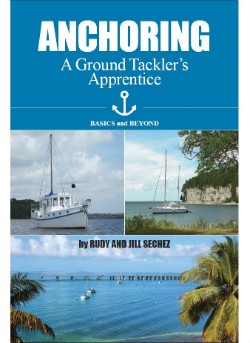A hand-cranked pencil sharpener instead of a battery or plug-in model? It often gets a few chuckles, but this is just one of the many things on our boat that helps to make our life simpler, easier, more convenient or safer; here are a few others:
Taming Wire, Ties, Clamps and Pins
Safety Wire- After mousing (safety wiring) a shackle's pin, take the end of that twisted-together tail in a pair of needle-nose pliers and tuck it under, sliding it between the wraps of wire and the shackle. This puts those sharp ends out of the way, unable to stab, poke, or cut.
Wire Ties- If you don't own a pair of flush-cutting nippers, trim the tail close with cutters that you do have; then trim again using a pair of toenail clippers for a more closely trimmed, smoother, and rounded end.
Hose Clamps- To minimize getting poked or cut by the end of a hose clamp, using a pair of needle-nose pliers, grip the end of the band from the side and bend it down, maybe even curling it completely under.
Cotter Pins- Using a pair of needle-nose pliers, curl the tips of the cotter pin, one side clockwise inside of itself, the other counterclockwise; if necessary, use a longer than normal cotter pin.

Utility Tarp- For the proverbial thousand and one uses, the ubiquitous utility tarp might just fall into this category. It can be used to keep nicks and dings from marring the boat's surface, and if made out of hefty-enough cotton duck it will keep spills from soaking through, something that many synthetic materials cannot do. You can hang it to block the elements, to keep out prying eyes, wrapped around a crew member for relief from sun, rain, wind or cold, or rigged to catch rain water. It can also, especially if constructed heavy enough, do double duty as a collision mat. Size can vary dependent on its purpose; ours are approximately three feet by four feet, give or take a foot or two.
Plywood Protectors- Several small plywood pads constantly find use on our boat to keep heavy items like anchors, outboards, and dinghies from scratching or dinging surfaces. We also place them under metal containers to keep rust stains off the deck. Ours are approximately ¼" x 8" x 8", give or take an inch or two.
Handy Billy- Three-part, as well as five-part block and tackle can find a myriad of uses, even on today's latest cruiser. Inexpensive, non-electric, low-tech, able to be taken to where needed, and with rope tails they are quiet flexible in their positioning. They can be used to pull a boat into the dock against a wind or current, with a winch that won't work or has an overwrap, tensioning rigging or other lines, or getting large or heavy items overboard or on deck.

Concerned that you don't have the skill to make or use these suggestions, just think, "How bad does it have to be not to work?" So go ahead to try, and don't limit yourself to these few ideas, become creative, think outside of the box, and if required, be unconventional.

Find out more about veteran cruisers Rudy and Jill Sechez, Trawler Training and Anchoring Consultants, at their website: trawlertrainingabc.com. You can purchase their book, "ANCHORING−A Ground Tackler's Apprentice" through Waterway Guide Ship Store (waterwayguide.com).












